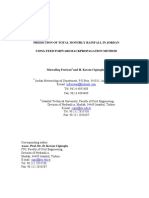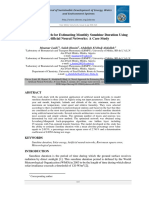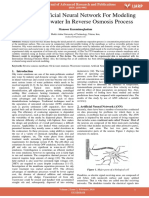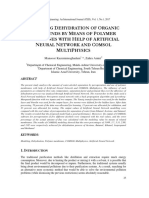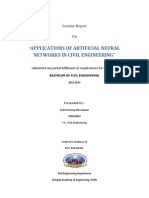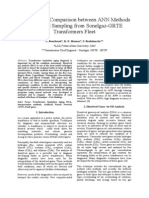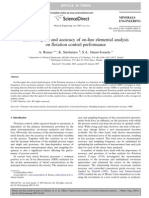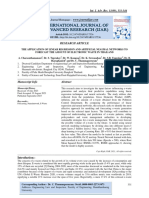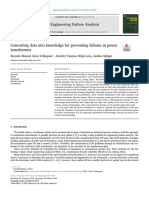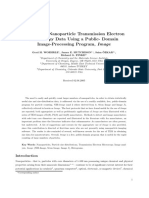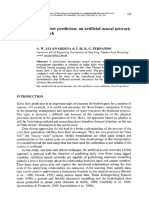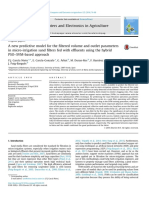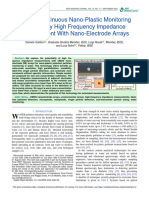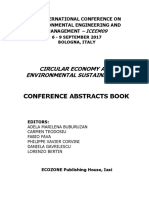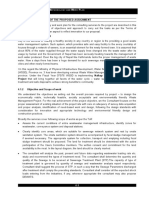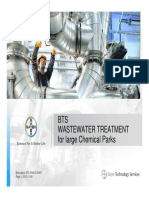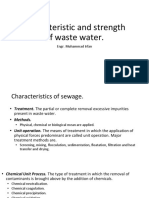UEE J: Prediction of Bod and Cod of A Refinery Wastewater Using Multilayer Artificial Neural Networks
UEE J: Prediction of Bod and Cod of A Refinery Wastewater Using Multilayer Artificial Neural Networks
Uploaded by
Antasari MalauCopyright:
Available Formats
UEE J: Prediction of Bod and Cod of A Refinery Wastewater Using Multilayer Artificial Neural Networks
UEE J: Prediction of Bod and Cod of A Refinery Wastewater Using Multilayer Artificial Neural Networks
Uploaded by
Antasari MalauOriginal Title
Copyright
Available Formats
Share this document
Did you find this document useful?
Is this content inappropriate?
Copyright:
Available Formats
UEE J: Prediction of Bod and Cod of A Refinery Wastewater Using Multilayer Artificial Neural Networks
UEE J: Prediction of Bod and Cod of A Refinery Wastewater Using Multilayer Artificial Neural Networks
Uploaded by
Antasari MalauCopyright:
Available Formats
Santos, Suzuki, Kashiwadani, Savic and Lopes
EE JU
Journal of Urban and Environmental Engineering, v.2, n.1, p.1-7 ISSN 1982-3932 doi: 10.4090/juee.2008.v2n1.001007
Journal of Urban and Environmental Engineering
www.journal-uee.org
PREDICTION OF BOD AND COD OF A REFINERY WASTEWATER USING MULTILAYER ARTIFICIAL NEURAL NETWORKS
Eldon R. Rene1 and M. B. Saidutta2
2 1 Department of Chemical Engineering, University of La Coruna, Spain Department of Chemical Engineering, National Institute of Technology Karnataka, Surathkal, India
Received 23 October 2007; received in revised form 19 March 2008; accepted 02 April 2008
Abstract:
In the recent past, artificial neural networks (ANNs) have shown the ability to learn and capture non-linear static or dynamic behaviour among variables based on the given set of data. Since the knowledge of internal procedure is not necessary, the modelling can take place with minimum previous knowledge about the process through proper training of the network. In the present study, 12 ANN based models were proposed to predict the Biochemical Oxygen Demand (BOD5) and Chemical Oxygen Demand (COD) concentrations of wastewater generated from the effluent treatment plant of a petrochemical industry. By employing the standard back error propagation (BEP) algorithm, the network was trained with 103 data points for water quality indices such as Total Suspended Solids (TSS), Total Dissolved Solids (TDS), Phenol concentration, Ammoniacal Nitrogen (AMN), Total Organic Carbon (TOC) and Kjeldahls Nitrogen (KJN) to predict BOD and COD. After appropriate training, the network was tested with a separate test data and the best model was chosen based on the sum square error (training) and percentage average relative error (% ARE for testing). The results from this study reveal that ANNs can be accurate and efficacious in predicting unknown concentrations of water quality parameters through its versatile training process.
Keywords:
Artificial neural networks; COD; BOD; sum square error; percentage average relative error; predictions
2008 Journal of Urban and Environmental Engineering (JUEE). All rights reserved.
Correspondence to: Eldon R. Rene. E-mail: eldonrene@yahoo.com
Journal of Urban and Environmental Engineering (JUEE), v.2, n.1, p.1-7, 2008
Rene and Saiduta
INTRODUCTION Industrial activities consume a huge amount of natural water, utilizable resources and energy thereby discharging enormous wastewater to the natural environment. It is therefore necessary to analyse any industrial wastewater to determine its reuse potential and the degree of treatment required prior to its ultimate disposal or to device suitable measures for the recovery of useful products. It is of great importance in water quality control that the amount of organic matter present in the system be known and that the quantity of oxygen required for its stabilisation be determined. Over the years, different physico-chemical tests have been developed to determine the organic and inorganic content of wastewater (Metcalf & Eddy, 1995). In general, these tests may be divided into those used to measure gross concentrations of organic matter greater than 1 mg/L and those used to measure trace concentrations in the range of 10-6 to 10-3 gm/L. Laboratory methods commonly used today to measure the gross amount of organic matter (greater than 1 mg/L) in wastewater includes the following: (a) Biochemical Oxygen Demand (BOD5), (b) Chemical Oxygen Demand (COD) and (c) Total Organic Carbon (TOC). These three parameters are used in wastewater treatment operations to estimate the influent and effluent characteristics and treatment efficiency. The use of TOC as an analytical parameter has become more common in recent years especially for the treatment of industrial wastewater. Partly, this is due to the fact that the TOC determinations can be carried out in triplicate within minutes compared with the five days required for the BOD5 test (Sawyer et al., 1994). Apart from these, the easily measurable parameter for any industrial wastewater includes indices like Total Suspended Solids (TSS), Total Dissolved Solids (TDS), Phenol concentration, Ammoniacal Nitrogen (AMN) and Kjeldahls Nitrogen (KJN) (Metcalf & Eddy, 1995). A review of the existing literature in this field reveals that correlation among these parameters seldom exists. It could be difficult to understand the dynamics of relationship between these parameters because they primarily depend on the process of the target industry, raw material/by-product composition, composition of chemicals discharged in wastewater and thus their nonlinear relationship makes universal generalization difficult. The main objective of this paper is to predict the BOD and COD concentrations of a refinery wastewater using different combinations of easily measurable water quality indices like TOC, TSS, TDS, Phenol, AMN and KJN using back error propagation (BEP) neural network. The best network architecture was determined by selecting the appropriate network topology.
ARTIFICIAL NEURAL NETWORKS The three-layer back propagation network has been proved to be universal function approximations in the field of environmental prediction (Poggio & Girosi, 1990). Neural networks has been applied to solve and predict problems related to the following; biodegradation kinetics of organic compounds (Shuurmann & Muller, 1994), estimating optimum alum doses in water treatment (Maier et al., 2004) and long term tidal waves (Lee, 2004). The ANN theory Neural networks are powerful data driven modelling tools that has the ability to capture and represent complex input/output relationships. The development of neural computational techniques emerged from the desire to develop an artificial system that could perform multiple, complex and intelligent tasks similar to those performed by the human brain. ANNs consists of a system of simple interconnected processing element called neurons. This gives the ability to model any non-linear process through a set of unidirectional weighted connections (Haykin, 1999). The neuron accepts input from single or multiple sources and produces output by a simple calculating process guarded by a non-linear transfer function. A three-layered network (Bandyopadhyay & Chattopadhyay, 2007) with an input layer, hidden layer and output layer is shown in Fig. 1. The input layer consists of a set of neurons, each representing an input parameter and propagates the raw information to the neuron in the hidden layer, which in turn transmits them to the neurons in the output layer. Each layer consists of several neurons and the layers are connected by the connection weights (W). The most commonly used transfer function is the sigmoid function as described by:
f (x ) =
1 1 + e x
(1)
Fig. 1 Schematic of a three layer neural network.
Journal of Urban and Environmental Engineering (JUEE), v.2, n.1, p.1-7, 2008
Rene and Saiduta
This produces output in the range of 01 and Table 1. Range of water quality parameters used for training and introduces non-linearity into the network, which gives testing Training Testing the power to capture nonlinear relationships. The back Sl. Parameters No. (mg/L) data data propagation network is the most prevalent supervised 1 BOD 234 13.52 6.134 15.61 ANN learning model (Rummelhart et al., 1986). It uses 2 COD 12160 61.64 38114 72.076 the gradient descent algorithm to correct the weights 3 TOC 3.118.5 8.21 418.5 9.67 4 TSS 471 18.60 641 18.13 between interconnected neurons (Maier & Dandy, 5 TDS 3431851 858.62 4801720 973.73 1998). 6 AMN 1.492 19.04 9.594 31.90 During the learning process of the network, the 7 KJN 1.893.4 20.83 10.396.8 34.48 algorithm computes the error between the predicted and 8 Phenol 0.080.8 0.29 0.10.8 0.31 specified target values at the output layer. The error function at the output layer can be defined by: evaluated by the Sum square error (SSE) values for training obtained directly from the software, while the 1 2 E = ( Od OP ) (2) test data was evaluated using percentage average 2 relative error, % ARE. Low SSE and low % ARE values theoretically mean that the predictions are precise and where, E is the error function, Od is the desired output accurate. and Op is the output predicted by the network. The percentage Average Relative Error (% ARE) was estimated from this relation, Important Network Parameters A good network architecture requires selecting the most dependable values of network parameters like: number of hidden layers, the number of neurons in the hidden layer NH, the activation function f(x), the learning rate of the network , epoch size , momentum term and training cycles TC. The best values for parameters: , , NH, and TC are normally estimated by a trial and error approach. The learning rate and momentum can play an important role in the convergence of the network. The value of a network affects the size of steps taken in weight space (Maier & Dandy, 1998). If is too small, the algorithm would take more time to converge. The momentum term accelerates the convergence of the error during the learning process by adding a fraction to the precious weight update. The values of and varies between 01 and is normally estimated by trial and error (Hamed et al., 2004). MATERIALS AND METHODS Data handling procedure The various wastewater parameters such as TSS, BOD, COD, TOC, phenol concentration, AMN, KJN and TDS were obtained from the quality control laboratory of a refinery located in Mangalore, India. Water samples collected from the effluent treatment plant after tertiary treatment were analyzed for the above mentioned parameters, which were later divided into training set (103) and test set (40). The ranges of various values of different parameters used for training and testing are shown in Table 1. Softwares used Neural network based predictions were simulated using the software NNMODEL. Their performance was
% ARE = AExpt APr ed | 1 100 N AExpt
(3)
ANN Based Models inputs and outputs A total of 12 ANN based models were evaluated in this study for predicting the BOD and COD of refinery wastewater. These models are shown in Table 2. RESULTS Prediction of BOD The training of these models were started with the default values of NN model with a training count of 1000 and 4 hidden neurons in the hidden layer. From the next trail, the optimum training count for the network was decided. This was done by trial and error by checking the SSE and the % ARE after each cycle of training. The optimum training count was the one which gave a minimum SSE and lower % ARE for the test data. After deciding the maximum training count for these models the number of hidden neurons in the hidden layer were varied by small increments by maintaining constant training count until the desired SSE and % ARE for the test data was obtained. The training was done for these models by varying the learning rates of the network (0.35 to 0.75) and it was observed that there was no significant change in the SSE values after training. However, by varying the training count and the number of neurons in the hidden layer, the performance of the network greatly improved. The variation of SSE with different training count and hidden layers for model A3 is shown in Table 3. From these values it was observed that the SSE tends to cease after a particular time of training and almost remains constant throughout the training period.
Journal of Urban and Environmental Engineering (JUEE), v.2, n.1, p.1-7, 2008
Rene and Saiduta
Table 2. Various models developed using neural networks and their best SSE values
Model No. A1 A2 A3 A4 A5 A6 A7 A8 A9 A10 A11 A12
Input Parameters TOC, phenol, TSS, TDS. TOC, phenol, TSS, TDS. TOC, Phenol, TSS, AMN TOC, Phenol, TSS, AMN TOC, Phenol, TSS, TDS, KJN TOC, Phenol, TSS TOC, Phenol,TSS TOC, Phenol, TSS, TDS, TOC, Phenol, TDS TOC, Phenol,TDS TOC TOC
Output BOD COD BOD COD BOD and COD BOD COD COD and BOD BOD COD BOD COD
Best SSE value 0.003 822 0.006 053 0.003 403 0.005 531 0.003 585 0.003 725 0.006 914 0.004 547 0.004 705 0.007 055 0.005 317 0.007 651
Prediction of COD The training was initially carried out with the default values of the software NNModel. Later, the optimum training count for the network was determined. The same procedure that was applied for BOD was followed, thereby varying the number of hidden neurons in the hidden layer in small increments and by maintaining constant training count till the desired SSE and % ARE for the test data was obtained. It was observed that the SSE tends to slow down without showing any decrement in its value and then tends to increase to a certain extent before again decreasing and then remaining constant throughout the remaining period of training. This kind of behavior was noticed in model A7 at a training count of 6000 and 9 hidden neurons in the hidden layer which produced a SSE of 0.008 413 which was quite high compared to the other training cycles. These models were also trained with different learning rates (0.5 to 0.75), but the network showed no positive improvement in reducing the SSE and the % ARE. Therefore, all these models were trained with the default values of NNModel for learning rates. The variation of SSE with the training count and hidden neurons in the hidden layer for the best model developed to predict COD is shown from Table 4. Prediction of BOD and COD in a combined model Two models were developed to predict BOD and COD simultaneously. The variation of SSE with different training count and different hidden layers for model A8 is shown in Table 5.
Table 3. Variation of SSE with different training count and hidden neurons for Model A3
The same procedure as followed earlier to determine the optimum training count and good SSE was followed for these models. DISCUSSION AND CONCLUSIONS The measured and predicted BOD and COD values from different models are shown in Figs 213 respectively. After each set of training, % ARE for the test data was calculated. The various % ARE values obtained for the test data using these models are shown in Table 6.
Table 4. Variation of SSE with different training count and hidden neurons for Model A10
Training count default 2000 2500 1000 1500 2500
Hidden neurons 4 4 5 6 8 8
Sum square error 0.007 400 0.007 324 0.007 463 0.007 345 0.007 055 0.007 155
Table 5. Variation of SSE with different training count and hidden neurons for Model A8
Training count default 2000 5000 5000 5000 7500 10 000
Hidden neurons 4 5 6 7 8 8 8
Sum square error 0.005 532 0.004 588 0.004 547 0.004 891 0.005 096 0.004 888 0.004 634
Training count default 5000 5000 5000 5000 7500 10 000
Hidden neurons 4 4 5 6 7 8 8
Sum square error 0.004 491 0.003 947 0.003 983 0.003 942 0.003 403 0.003 481 0.003 946
Table 6. %ARE for the BOD and COD test data
Model No (BOD) A1 A3 A6 A9 A11
% ARE 14.7479 11.6614 12.8236 15.0126 12.8982
Model No (COD) A2 A4 A7 A10 A12
% ARE 13.4163 13.5600 15.9200 6.9729 10.0821
Journal of Urban and Environmental Engineering (JUEE), v.2, n.1, p.1-7, 2008
Rene and Saiduta
Model A-1 40
COD, mg / l 160 140
Model A-2 Measured Predicted
35 BOD, mg / l 30 25 20 15 10 5 0 Number of data points (40)
Fig. 2 Measured and predicted test data for BOD concentration from Model A-1.
Measured Predicted
120 100 80 60 40 20 0
Number of data points (40)
Fig. 3 Measured and predicted test data for COD concentration from Model A-2.
Model A-3 40 35 BOD, mg / l 30 25 20 15 10 5 0 Number of data points (40)
Fig. 4 Measured and predicted test data for BOD concentration from Model A-3.
Model A-4 150 COD, mg / l Measured Predicted 100
Measured Predicted
50
0 Number of data points (40)
Fig. 5 Measured and predicted test data for COD concentration from Model A-4.
Model A-5 40 35 BOD, mg / l 30 25 20 15 10 5 0 Number of data points (40)
140
Model A-5
Measured
COD, mg / l
120 100 80 60 40 20 0 Number of data points (40) Measured Predicted
Predicted
(a) (b) Fig. 6 Measured and predicted test data for (a) BOD and (b) COD concentration from Model A-5.
Journal of Urban and Environmental Engineering (JUEE), v.2, n.1, p.1-7, 2008
Rene and Saiduta
Model A-6 50 BOD, mg / l
Model A-7 160 COD, mg / l 140 120 100 80 60 40 20 0 Measured Predicted
40 30 20 10 0
Measured Predicted
Number of data points (40)
Fig. 7 Measured and predicted test data for BOD concentration from Model A-6.
Number of data points (40)
Fig. 8 Measured and predicted test data for COD concentration from Model A-7.
Model A-8 40 35 BOD, mg / l 30 25 20 15 10 5 0 Number of data points (40)
Model A-8 140 COD, mg / l 120 100 80 60 40 20 0 Number of data points (40) Measured Predicted
Measured Predicted
(a) (b) Fig. 9 Measured and predicted test data for (a) BOD and (b) COD concentration from Model A-8.
40 BOD, mg / l 35 30 25 20 15 10 5 0
Model A-9 Measured Predicted
140 COD, mg / l 120 100 80 60 40 20 0
Model A-10
Measured Predicted Number of data points (40)
Number of data points (40)
Fig. 10 Measured and predicted test data for BOD concentration from Model A-9.
Fig. 11 Measured and predicted test data for COD concentration from Model A-10.
Model A-11 40 BOD, mg / l
COD, mg / l 140
Model A-12 120 100 80 60 40 20 Measured Predicted Number of data points (40)
Fig. 13 Measured and predicted test data for COD concentration from Model A-12.
30 20 10 0
Measured Predicted
Number of data points (40)
Fig. 12 Measured and predicted test data for BOD concentration from Model A-11.
Journal of Urban and Environmental Engineering (JUEE), v.2, n.1, p.1-7, 2008
Rene and Saiduta
From this table, it is evident that the Model A3 with TOC, Phenol, TSS and AMN as the input parameters was the best model for predicting BOD with a SSE of 0.003 403 in the training data and % ARE of 11.6614 when tested with the test data. Model A3 gave good results at a training count of 5000 and 7 hidden neurons in the hidden layer. All the other models showed comparatively poorer results than model A3 while both training and testing. While testing model A3 with the 40 test datas, 21 (52%) data points were found to be within the 10% limit. Similarly, for the different models developed to predict COD, it was inferred that model A10 with TOC, Phenol and TDS as the input parameters produced better results for predicting COD. This model was formulated with a training count of 1500 and 8 hidden neurons in the hidden layer indicating the training capability of the network. This model gave a SSE of 0.007 055 and when tested with the test data yielded % ARE of 6.9729, which was remarkably good compared to the other models. It is noteworthy to mention that, out of the 40 data points used for testing the network, 30 (75%) data points were found to be within the 10% level of significance. On the other hand, from the results obtained for models developed to predict both BOD and COD simultaneously, it was clearly evident that model A8 with TOC, Phenol, TSS and TDS as the input parameters was able to predict good results for both BOD and COD compared to model A5. Model A8 produced showed better results at a training count of 5000 and 6 hidden neurons in the hidden layer. This model gave a SSE of 0.004547 for the training data and when tested with an external test data gave % ARE of 8.201 for BOD and 11.0835 for COD. This model gave commendable results when compared with the previous best model for BOD (A3) that produced a SSE of 0.003 403 and % ARE of 11.6614, however for COD it was able to produce satisfactory results compared to the best model for COD (A10). During BOD predictions, 57% (23/40) of the error residuals were found to be below 10% of the measured value, while for COD it was 67% (27/40). The results of models obtained from NN Model collectively show good statistical significance at the 10% level for the test data. Model A3, was able to predict BOD using TOC, Phenol, TSS, AMN as the model inputs, while Model A10 at a training count of
5000 and 7 hidden neurons in the hidden layer, while Model A10 gave good results for COD using TOC, Phenol and TDS as the inputs at a training count of 1500 and 8 hidden neurons. Interestingly, the combined model A8 developed to predict both BOD and COD was found more effective using TOC, Phenol, TSS and TDS as the inputs. The results from this neural prediction showed very less % ARE values, indicating that the predictions are highly acceptable. Similar data driven modelling approaches can be developed to suit any industrial situation to predict fluctuating effluent concentrations well in advance. Acknowledgement The authors would like to thank the refinery Senior Manager, Mr. S. Ramesh and the Lab Supervisor Mr. H. Shreekrishna Sharma, for their help during the course of this research work. REFERENCES
Bandyopadhyay, G. & Chattopadhyay, S. (2007) Single hidden layer artificial neural network models versusmultiple linear regression model in forecasting the time series of total ozone. Int. J. Environ. Sci. Tech. 4(1), 141149. Hamed, M.M., Khalafallah, M.G., Hassanien, E.A. (2004) Prediction of wastewater treatment plant performance using artificial neural networks. Environ. Mod. Soft. 19, 919928. Haykin, S. (1999) Neural Networks A comprehensive foundation. 6th Indian reprint, Pearson Education, Inc. Singapore. Hornik, K., Stinchcombe, M., White, H. (1989) Multilayer feed forward networks as universal approximators, Neural Networks 2, 359356. Lee, T-L. (2004) Back-propagation neural network for long-term tidal predictions. Ocean Eng. 21, 225238. Maier, H.R., Morgan, N., Chow, C.W.K. (2004) Use of artificial neural networks for predicting optimal alum doses and treated water quality parameter. Environ. Mod. Soft. 19, 485494. Maier, H.R. & Dandy, G.C. (1998) The effects of internal parameters and geometry on the performance of back propagation neural networks: an empirical study. Environ. Mod. Soft. 13, 193209. Metcalf, E. (1995) Wastewater Engineering, Treatment, Disposal and Reuse. 5th Edition, McGraw Hill, NY. Poggio, T., Girosi, F., (1990) Networks for approximation and learning. Proc. IEEE, 78(9), 14811497. Rummelhart, D.E., Hinton, G.E., Williams, R.J. (1986). Learning representations by back-propagation errors. Nature 323, 533536. Sawyer C.N., McCarty P.L., Parkin G.F. (1994) Chemistry for Environmental Engineering. 4th Edition, McGraw-Hill International Editions. Schuurmann, G., Muller, G. (1994) Back-propagation neural networks recognition vs. prediction capability. Environ. Toxicol. Chem. 13, 743747.
Journal of Urban and Environmental Engineering (JUEE), v.2, n.1, p.1-7, 2008
You might also like
- Resource Scarcity and Textile ProductionDocument43 pagesResource Scarcity and Textile ProductionDiego BartolomeNo ratings yet
- References ASEAN2Document3 pagesReferences ASEAN2M IrwaniNo ratings yet
- 108220080211Document8 pages108220080211exionking ProNo ratings yet
- Neural Network, Sewage TreatmentDocument10 pagesNeural Network, Sewage TreatmentKumar GauravNo ratings yet
- PaperDocument29 pagesPaperAop BolvadinNo ratings yet
- Estimationof BODinwastewaterbyusingdifferent ANNalgorithmstreatmentplantDocument9 pagesEstimationof BODinwastewaterbyusingdifferent ANNalgorithmstreatmentplantpharmacistnafiNo ratings yet
- Novel Approach For Estimating Monthly Sunshine Duration Using Artificial Neural Networks: A Case StudyDocument10 pagesNovel Approach For Estimating Monthly Sunshine Duration Using Artificial Neural Networks: A Case StudyLAIDI MaamarNo ratings yet
- Sustainability 14 15598Document35 pagesSustainability 14 15598Simón OsésNo ratings yet
- Modeling of Ambient Air Pollutants ThrouDocument4 pagesModeling of Ambient Air Pollutants ThrouRahul KumarNo ratings yet
- Neural Based PH System in Effluent Treatment ProcessDocument11 pagesNeural Based PH System in Effluent Treatment Processmaheswaribalaji2010No ratings yet
- Using of Artificial Neural Network For Modeling of Oily Wastewater in Reverse Osmosis ProcessDocument5 pagesUsing of Artificial Neural Network For Modeling of Oily Wastewater in Reverse Osmosis ProcessIJARP PublicationsNo ratings yet
- Applied Mathematical ModellingDocument13 pagesApplied Mathematical ModellinghawNo ratings yet
- Article AI - Pollution de L'eau Salamani IrelandDocument8 pagesArticle AI - Pollution de L'eau Salamani IrelandLIYOUCK Patrice RolandNo ratings yet
- Estimation of Binary Infinite Dilute Diffusion Coefficient Using Artificial Neural NetworkDocument19 pagesEstimation of Binary Infinite Dilute Diffusion Coefficient Using Artificial Neural NetworkrezaNo ratings yet
- Placement of Flow and Concentration SensorsDocument54 pagesPlacement of Flow and Concentration SensorsYaqoob AliNo ratings yet
- Jar TestDocument14 pagesJar TestMohamed EhabNo ratings yet
- CEIJDocument16 pagesCEIJceijjournalNo ratings yet
- Artificial Neuron Models For Hydrological Modeling: Seema Narain and Ashu JainDocument5 pagesArtificial Neuron Models For Hydrological Modeling: Seema Narain and Ashu JainseemanarainNo ratings yet
- 05 - Soft Sensor Reactor SDocument9 pages05 - Soft Sensor Reactor SMayer FernandesNo ratings yet
- Gómez-Camperos 2019 J. Phys. - Conf. Ser. 1388 012032Document7 pagesGómez-Camperos 2019 J. Phys. - Conf. Ser. 1388 012032Raihan RizkyNo ratings yet
- Civil-Applications of Artificial Neural Networks in Civil EngineeringDocument25 pagesCivil-Applications of Artificial Neural Networks in Civil Engineeringsateeshsingh100% (1)
- International Communications in Heat and Mass TransferDocument5 pagesInternational Communications in Heat and Mass TransferMossa LaidaniNo ratings yet
- Multi Objective OptimizationDocument10 pagesMulti Objective OptimizationRitunjay JhaNo ratings yet
- Chem TechDocument7 pagesChem TechAMA TUBENo ratings yet
- Forecasting PM10 Concentrations Using Artificial Neural Network in Imphal CityDocument10 pagesForecasting PM10 Concentrations Using Artificial Neural Network in Imphal CityInternational Journal of Innovative Science and Research TechnologyNo ratings yet
- Nonlinear Identification of PH Process by Using Nnarx Model: M.Rajalakshmi, G.Saravanakumar, C.KarthikDocument5 pagesNonlinear Identification of PH Process by Using Nnarx Model: M.Rajalakshmi, G.Saravanakumar, C.KarthikGuru SaravanaNo ratings yet
- DTSpaper110915 PDFDocument9 pagesDTSpaper110915 PDFManohar LalNo ratings yet
- IV-11 Bouchaoui SetifDocument6 pagesIV-11 Bouchaoui SetifbaoHVLABNo ratings yet
- Sediment Transport Prediction by Using 3-Layer Feedforward MLP NetworksDocument7 pagesSediment Transport Prediction by Using 3-Layer Feedforward MLP NetworksAkhmad HananNo ratings yet
- Chimicaxy 1Document11 pagesChimicaxy 1Franx KpdxNo ratings yet
- TKK01Document12 pagesTKK01Evarist EdwardNo ratings yet
- Artificial Intelligence in Gravel PackingDocument22 pagesArtificial Intelligence in Gravel PackingUgomuoh Tochukwu TheophineNo ratings yet
- The Application of Linear Regression and Artificial Neaural Networks To Forecast The Amount of Electronic Waste in ThailandDocument14 pagesThe Application of Linear Regression and Artificial Neaural Networks To Forecast The Amount of Electronic Waste in ThailandIJAR JOURNALNo ratings yet
- ALD Con Mode 2Document14 pagesALD Con Mode 2Gerald See TohNo ratings yet
- Bioresource TechnologyDocument11 pagesBioresource TechnologyShaik HussainNo ratings yet
- Fusao de SensoresDocument15 pagesFusao de SensoresFelipe KaewNo ratings yet
- Monitoring and Detecting Faults in Wastewater Treatment Plants Using Deep LearningDocument12 pagesMonitoring and Detecting Faults in Wastewater Treatment Plants Using Deep LearningSuman DasNo ratings yet
- PCCP Sarah 2006Document13 pagesPCCP Sarah 2006Fitra Isni RositaNo ratings yet
- Analysis of Nanoparticle Transmission Electron Microscopy Data Using A Public - Domain Image-Processing Program, Image (#142572) - 123995Document13 pagesAnalysis of Nanoparticle Transmission Electron Microscopy Data Using A Public - Domain Image-Processing Program, Image (#142572) - 123995Alan TiradoNo ratings yet
- Etong Ini TentangDocument6 pagesEtong Ini TentangSuginoMarwotoNo ratings yet
- Box Behnken Microbial Fuel CellsDocument33 pagesBox Behnken Microbial Fuel CellsMaria De La HozNo ratings yet
- ANN Modeling and GA Optimization of Zinc Removal From Wash Water by Electro-Coagulation ProcessDocument7 pagesANN Modeling and GA Optimization of Zinc Removal From Wash Water by Electro-Coagulation ProcessRahul SharmaNo ratings yet
- Jem WWTPDocument12 pagesJem WWTPvacomanoNo ratings yet
- Can Machine Learning and Predictor Selection Algorithms Yield Reliable Stream Flow Prediction?Document10 pagesCan Machine Learning and Predictor Selection Algorithms Yield Reliable Stream Flow Prediction?malaya_mohantyNo ratings yet
- Development of SO Prediction Model With Artificial Neural Network For Pune CityDocument8 pagesDevelopment of SO Prediction Model With Artificial Neural Network For Pune CityInternational Journal of Application or Innovation in Engineering & ManagementNo ratings yet
- Iahs 268 0239Document7 pagesIahs 268 0239Luay Kadhim Al-WaeliNo ratings yet
- Quantification of River Total Phosphorus Using Machine LearningDocument17 pagesQuantification of River Total Phosphorus Using Machine LearningZAHER MUNDHER YASEENNo ratings yet
- Flow Design of Sewerage System - A CaseDocument4 pagesFlow Design of Sewerage System - A CaseHanafi NidzamNo ratings yet
- Evaluation of Artificial Neural Network and Time Series Models To Simulate Groundwater LevelsDocument4 pagesEvaluation of Artificial Neural Network and Time Series Models To Simulate Groundwater LevelsinventionjournalsNo ratings yet
- Archive of SID: Novel Fusion Approaches For The Dissolved Gas Analysis of Insulating OilDocument12 pagesArchive of SID: Novel Fusion Approaches For The Dissolved Gas Analysis of Insulating OilelshamikNo ratings yet
- Mirzaee 2021Document13 pagesMirzaee 2021Fatokhoma amadou CamaraNo ratings yet
- Fault Detection in A Continuous PulpDocument8 pagesFault Detection in A Continuous PulpMorenazo20No ratings yet
- Topics 11 and 21 HL Measurement and Data ProcessingDocument23 pagesTopics 11 and 21 HL Measurement and Data ProcessingDuddlie YuNo ratings yet
- Use of Artificial Neural Networks For Estimating Water Content of Natural GasesDocument8 pagesUse of Artificial Neural Networks For Estimating Water Content of Natural GasesemenneNo ratings yet
- Modelling of A Coagulation Chemical Dosing Unit For Water Treatment Plants Using Fuzzy Inference System ?Document7 pagesModelling of A Coagulation Chemical Dosing Unit For Water Treatment Plants Using Fuzzy Inference System ?JoseNo ratings yet
- Computers and Electronics in Agriculture: Original PapersDocument7 pagesComputers and Electronics in Agriculture: Original Papersahmed sayarehNo ratings yet
- Estimating Evapotranspiration Using Artificial Neural NetworkDocument10 pagesEstimating Evapotranspiration Using Artificial Neural NetworkRajendra SinghNo ratings yet
- Toward Continuous Nano-Plastic Monitoring in Water by High Frequency Impedance Measurement With Nano-Electrode ArraysDocument9 pagesToward Continuous Nano-Plastic Monitoring in Water by High Frequency Impedance Measurement With Nano-Electrode ArraysSupriya GowdaNo ratings yet
- Applsci 10 05776 With CoverDocument50 pagesApplsci 10 05776 With Coverriswanarif456No ratings yet
- M 0362international Journal of Computational Engineering Research (IJCER) 075081Document7 pagesM 0362international Journal of Computational Engineering Research (IJCER) 075081International Journal of computational Engineering research (IJCER)No ratings yet
- Deterministic Insight Into ANN Model Performance For Storm Runoff SimulationDocument16 pagesDeterministic Insight Into ANN Model Performance For Storm Runoff SimulationDavid JimenezNo ratings yet
- Book of Abstracts ICEEM09 2017Document490 pagesBook of Abstracts ICEEM09 2017coada100% (1)
- A Power Point Presentation On: DistilleriesDocument3 pagesA Power Point Presentation On: DistilleriesLokeshNo ratings yet
- Fin650 Lectures 10 Environmental AppraisalDocument51 pagesFin650 Lectures 10 Environmental AppraisalTrần ThiNo ratings yet
- Assignment of Food Processing Plant Layout and DesignDocument9 pagesAssignment of Food Processing Plant Layout and DesignSadasis SinghNo ratings yet
- Physico-Chemical Characterization of Distillery Effluent and Its Dilution Effect at Different LevelsDocument11 pagesPhysico-Chemical Characterization of Distillery Effluent and Its Dilution Effect at Different LevelsSiddu RhNo ratings yet
- Kopya NG PAES616-WastewaterReuseforIrrigation PDFDocument9 pagesKopya NG PAES616-WastewaterReuseforIrrigation PDFJohn Paulo PeridoNo ratings yet
- 402 1 TGD Watmonitor 0112v2Document27 pages402 1 TGD Watmonitor 0112v2Js TanNo ratings yet
- Sewage Treatment PlantDocument129 pagesSewage Treatment PlantzfrlNo ratings yet
- Nov. 15 2021 Grand Forks Fufeng Group PresentationDocument15 pagesNov. 15 2021 Grand Forks Fufeng Group PresentationJoe BowenNo ratings yet
- Rules and Standards: German Atv-DvwkDocument25 pagesRules and Standards: German Atv-DvwkMehmet Emre Bastopcu100% (2)
- Mohd Shukri Abdul Razik MFKA2007 TTTDocument82 pagesMohd Shukri Abdul Razik MFKA2007 TTTCat VelNo ratings yet
- Agua IngDocument29 pagesAgua IngAdrian FrantescuNo ratings yet
- Industrial Estate Members' ProfileDocument48 pagesIndustrial Estate Members' ProfileHaidee HernandezNo ratings yet
- Pre Feasibility Report For Production of Acid Slurry (Labsa 100%) atDocument24 pagesPre Feasibility Report For Production of Acid Slurry (Labsa 100%) atprashant kumar0% (1)
- To Contents CDDocument14 pagesTo Contents CDAimy Eyra100% (1)
- Refinery Waste Water Treatment and ReuseDocument8 pagesRefinery Waste Water Treatment and ReuseMahmood VahidNo ratings yet
- U2S3-4 - Environmental Impact of Textile IndustriesDocument9 pagesU2S3-4 - Environmental Impact of Textile IndustriesHieu100% (7)
- Sch3u Chapter 7 AllDocument21 pagesSch3u Chapter 7 AllRuthNo ratings yet
- Form Tech-3D Description of The Methodology and Work PlanDocument16 pagesForm Tech-3D Description of The Methodology and Work PlanSurendra MaharjanNo ratings yet
- The Korean Pump Companies of 2011 Pumpro Glo-Biz Meeting in KoreaDocument2 pagesThe Korean Pump Companies of 2011 Pumpro Glo-Biz Meeting in KoreaLim DongseopNo ratings yet
- Lecture 1: Introduction To Aquatic EnvironmentsDocument137 pagesLecture 1: Introduction To Aquatic EnvironmentsEnzo TapingNo ratings yet
- Ra 9275Document4 pagesRa 9275Jenesa Marie DuroNo ratings yet
- Treatment of Cosmetic Waste WaterDocument5 pagesTreatment of Cosmetic Waste WaterfamNo ratings yet
- Bayer Aeration SystemDocument21 pagesBayer Aeration SystemRonaldo LeiteNo ratings yet
- 4 Characteristic of Waste Water PDFDocument25 pages4 Characteristic of Waste Water PDFInzi KhanNo ratings yet
- Man and Natural Environment 2Document96 pagesMan and Natural Environment 2GuruKPONo ratings yet
- Water Sector Damage Assessment 2014Document26 pagesWater Sector Damage Assessment 2014Dan CohenNo ratings yet
- University of Nairobi: Feb 540: Engineering Project-Report 2017/2018Document62 pagesUniversity of Nairobi: Feb 540: Engineering Project-Report 2017/2018macklyn tyanNo ratings yet




